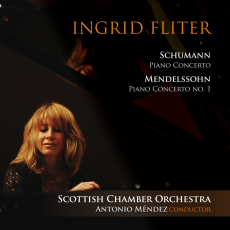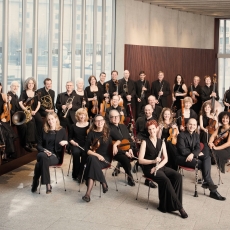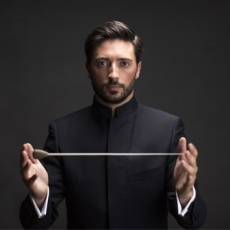Ingrid Fliter & SCO - Schumann & Mendelssohn: Piano Concertos - Audiophile Audition
Chopin specialist Ingrid Fliter is equally at home in two of the Polish composer's distinguished contemporaries.
Both Schumann and Mendelssohn wrote single-movement concerted works for piano: Schumann two and Mendelssohn three. In an era when audiences were more prone to listen to a series of short works, or even bits and pieces of longer works, on a concert program, compact concerti such as Schumann's Introduction and Allegro Appassionato or Mendelssohn's Capriccio Brilliant had currency. Today, you rarely if ever hear such pieces in concert, so it was a blessing in disguise that publishers turned down Schumann's one-movement Phantasie in A Minor when he offered it to them. He set the work aside, but through the urging of his wife Clara, Schumann decided four years later, in 1845, to add the Intermezzo and Allegro vivace finale that complete his Piano Concerto Op. 54.
As in the case of Schumann's Second Symphony composed a year later, working on the Piano Concerto was an act of musical therapy. In 1844 the Schumanns set out on a tour of Russia, a grueling experience in those days before railroads had penetrated into the depths of Eastern Europe. What's more, the tour was Clara's show; Schumann was less than second fiddle to her and felt alienated during the trip, resulting in one of his severe bouts of depression, which were always accompanied by physical symptoms as well. The upshot was that Schumann became incapable of composing for several months. But as his health slowly returned, he set about the completion of the concerto, which has become one of the great staples of the pianist's repertoire.
In writing the concerto, Schumann had anything in mind but the sort of flashy virtuoso fare written by the likes of Henri Herz or Friedrich Kalkbrenner. Instead, Schumann wrote a work of poetic refinement in which piano and orchestra engage in an intimate dialog and interplay not appreciated by Schumann's friend and sometime supporter Franz Lizst, who could be unpolitic in dealing with his acquaintances. Alluding to the subtitle of Schumann's gruelingly difficult Piano Sonata No. 3, Liszt joked that Schumann had already written the concerto without orchestra, so now he's turned the tables, producing the concerto without piano! Perhaps for Liszt the piano part is too subtle and unshowy, but in the hands of a gifted pianist it has great dash, even glitter.
There are simply too many recordings of this beloved work to offer a series of comparison, but be it said that I've listened to my fair share of them and believe that Ingrid Fliter's performance can hold its own among the best I've heard. Fliter plays with the kind of subtle rubato that brings a work such as Schumann's alive. She understands the composer's special brand of poetry well and shapes her phrases with an ear to the subtle interplay of tempo and dynamics. I also appreciate the contribution of the very fine Scottish Chamber Orchestra. This is music of such intimacy that a chamber orchestra is just the right accompanying body, and because of the reduced number of string players involved, winds and brass register with a force they just don't when a symphony orchestra is involved; sample the tutti passage just before the development section, with its brass fanfares. Timpani also-just listen to the last six measures of the work, where conductor Antonio Mendez lets the timpanist (David Corkhill) cut loose! In the more intimate pages, including the tender Intermezzo, pianist and orchestra are hand-in-glove as well.
Mendelssohn's First Concerto was written fourteen years before the Schumann, when the composer was all of twenty-two years old. So it is a young man's work, full of energy and brio, and unlike Schumann, Mendelssohn's aim was to emulate the virtuoso piano concertos of the day such as those by Weber or Moscheles. Mendelssohn wrote it for sixteen-year-old Munich pianist Delphine von Schauroth, with whom he seems to have been infatuated. However, there are no obvious love messages woven into the fabric of the concerto, which begins in a fiery G minor, flows without pause into a dreamy Andante, and then hurtles into a whirling Presto, again without pause. Brass fanfares act as a bridge between movements, a pretty novel approach to the concerto form.
Before long, Mendelssohn's concerto established itself in the repertoire to such an extent that as note-writer Clive Brown recounts, Berlioz in his Memoirs fantasizes that the piano used for auditions at the Conservatoire had been subjected so many times to the concerto that it could play the piece on its own; the only way to silence the beast was to chop it up and use it as kindling.
Fliter and Mendez approach the piece with bravura effect in mind: the first movement is sternly propulsive, the second all sweetness and light before the whirlwind finale. As it should be, the performance contrasts markedly with the Schumann. This is the work of a Classicist, as Brahms considered Mendelssohn, architecturally sound, focused in its approach, with little room for poetic gestures. In that respect the performance differs from my comparison recordings with Sergei Edelman, Claus Peter Flor, and the Bamberg Symphony (RCA). These performers do find a bit more poetry in the work, and include somewhat more rhythmic flexibility and dynamic shading. They're both fine performances, but Fliter and Mendez benefit from really first-rate SACD sound.
As a makeweight, the Linn disc includes a performance of Mendelssohn's Fair Melusina Overture, written in response to an opera that Mendelssohn didn't think much of: Conradin Kreutzer's Melusine. However, Mendelssohn, always with an eye for the ladies, was taken by the performance of one Fräulein Hähnel, "who was very fascinating, especially in one scene, where she appeared as a mermaid combing her hair. . . ." Mendelssohn continues in a letter to his sister Fanny, "this inspired me with the wish to write an overture. . . ." And so he did, one of his finest, with a watery first theme and a powerful second theme that propels the drama of the development section before the piece fades away with a reiteration of the opening melody. Conductor Mendez gives us an ardent version of the piece, again greatly aided by the excellent recording.
In the concertos, the piano, beautifully reproduced, is placed in a realistic relation to the orchestra. Both are recorded with great fidelity and impact, making this a thoroughly satisfying listening experience.



